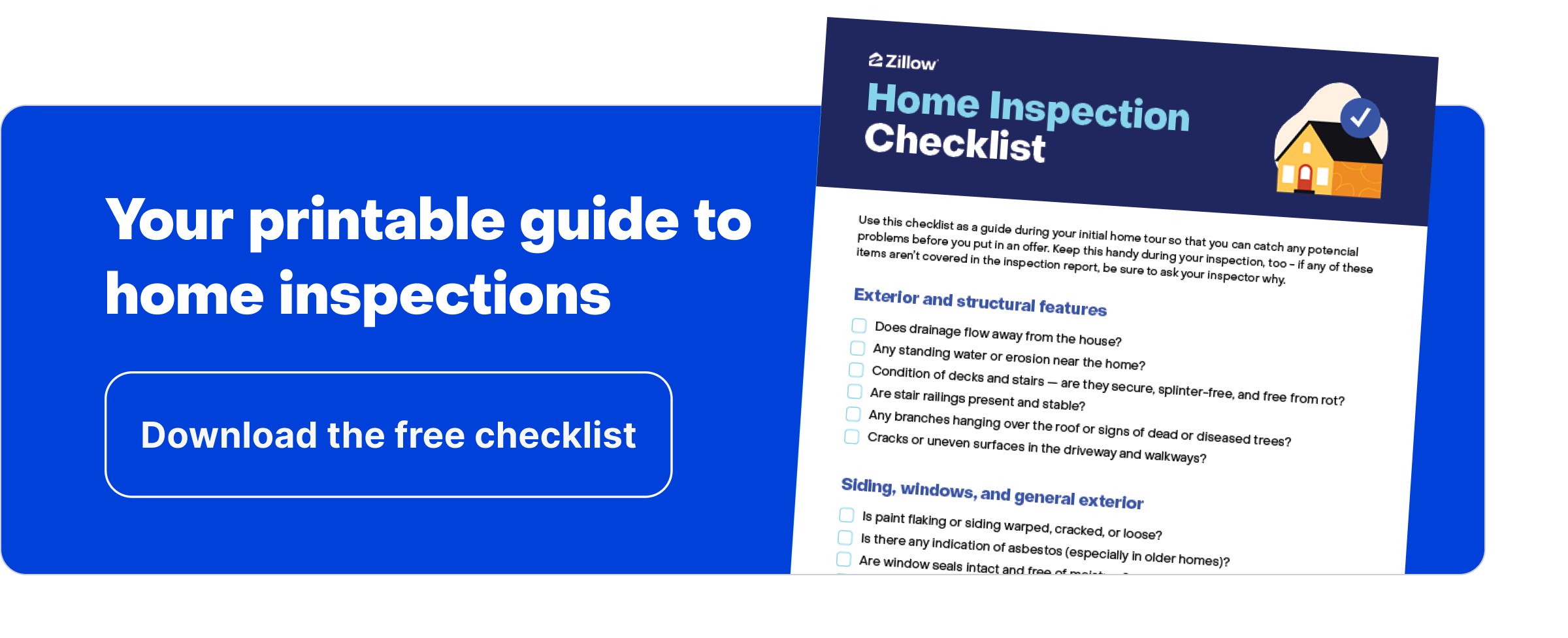House Inspection Checklist: What Do Home Inspectors Look For?
Home inspections are sometimes a major turning point in the home buying process. Knowing what to look for — whether you’ve found a place you like, or you’re still on the hunt — can prevent unpleasant surprises.


Written by Jennifer Lyons on September 30, 2025
Reviewed by Orphe Divounguy and Jeff Rankin, Edited by Alycia Lucio
Key takeaways
- What’s on the checklist: A home inspection reviews major systems and components, including roof, foundation, plumbing, electrical, HVAC, and appliances.
- What inspectors look for: safety hazards, needed repairs, and signs of damage such as leaks, cracks, or pests are all on the list.
- How buyers use inspection results: Buyers can use inspection results to negotiate repairs, request credits, or walk away if contingencies allow.
Whether you’re a home buyer or a seller, conducting a thorough home inspection can alert you to hidden problems and red flags early. It’s essential to understand what a home inspector is looking for as they conduct their assessment, so that you can take informed next steps. If you’re selling, use this home inspection checklist to prepare for a pre-inspection and if you’re buying, refer to it on inspection day. Even better: bring the checklist to home tours to help spot potential issues before putting in an offer. After all, it’s easy to get swept up in the excitement of a potential new home — the spacious rooms, natural light, and charming details — but don’t overlook the importance of a detailed inspection to make sure the home is safe and livable.
Be sure to share any concerns you have with your home inspector so they can give those areas a closer look on inspection day.
Exterior and structural features
Before you even step through the front door, the home’s exterior is already telling a story. Maybe the rain water is pulling alongside the foundation, the porch squeaks with each step, or the landscaping is a bit in disarray. These little details can reveal a lot about how well the home has been cared for. This is also where costly issues tend to hide in plain sight, so it’s worth taking your time here.
- Does drainage flow away from the house?
- Any standing water or erosion near the home?
- Condition of decks and stairs — are they secure, splinter-free, and free from rot?
- Are stair railings present and stable?
- Any branches hanging over the roof or signs of dead or diseased trees?
- Cracks or uneven surfaces in the driveway and walkways?
Foundation
The foundation holds everything together, literally. A small crack might be no big deal…or it might be a warning sign. Your inspector can help you get clarity, but these are the first things to look out for. Pay close attention here; it could save you major headaches (and expenses) later on.
- Are there cracks in walls, ceilings, or exterior foundation walls?
- Are trees or roots too close to the foundation?
- Are there signs of pest entry points or soil movement?
- Do any areas look like they’ve been patched or repaired?
If you’re buying with a home inspection contingency, your inspector’s findings in this area can become a key part of your decision-making process.
Siding, windows, and general exterior
Peeling paint or loose siding isn’t just about curb appeal, it can be a sign that water’s getting in or that maintenance has been delayed. A quick walk around the house can help you spot issues that might not seem obvious at first glance but could lead to bigger problems over time.
- Is paint flaking or siding warped, cracked, or loose?
- Is there any indication of asbestos (especially in older homes)?
- Are window seals intact and free of moisture?
- Do exterior lights function — including motion sensors?
- Is the garage door working properly, with a functional safety sensor?
- Are all porches and railings sturdy and in good shape?
Roof
The roof is one of the most important, and most expensive, parts of a home to replace. Signs of wear here can mean water intrusion, mold, or structural problems. Even if you can’t climb up there yourself, a visual check from the ground can tell you a lot. Don’t be afraid to ask how old the roof is or whether it’s had any recent repairs.
- Are shingles missing, curled, or cracked?
- Any signs of moss, algae, or pooling water?
- Is flashing secure and in good condition?
- Are gutters and downspouts properly connected and free of debris?
- Is the chimney stable and free of cracks?
Attic
The attic is often out of sight, but it holds valuable clues about how a home is breathing, aging, and protecting you from the elements.
- Are there any visible water stains or leaks?
- Is there sufficient insulation coverage?
- Is the attic well-ventilated?
- Any signs of pests, nests, or entry points?
Basement and crawlspace
Crawlspaces and basements may not be glamorous, but they’re where some of the home’s biggest red flags tend to show up. From hidden moisture and mold to structural concerns and pest activity, this is the area that tells you what’s happening beneath the surface. Even in newer homes, these spaces deserve careful attention.
- Any signs of water damage, staining, or mold?
- Is the insulation intact and sufficient?
- Does the sump pump (if present) function?
- Are there signs of pest activity, especially termites or rodents?
- Are the structural beams solid and free of cracks or sagging?
- Are vapor barriers or drainage systems present in crawlspaces?
Plumbing
Poor drainage, hidden leaks, or outdated materials can lead to water damage and big repair bills. It’s especially important to pay attention to water pressure, drainage speed, and the age of the water heater. Even minor plumbing issues can quickly turn into major ones if they’re overlooked.
- Has the sewer line been scoped (especially in older homes)?
- What’s the age and condition of the water heater?
- Do all fixtures (sinks, tubs, toilets) drain and refill correctly?
- Is water pressure strong and consistent?
- Are pipes visible, accessible, and free from corrosion or leaks?
Electrical
A safe, modern electrical system is essential not just for daily living but also for future renovations or adding tech upgrades. Little signs like ungrounded outlets or an outdated panel can point to bigger updates you might need down the road.
- Do switches and lights work in every room?
- Are outlets grounded, especially near sinks?
- Is the electrical panel updated and clearly labeled?
- Are there signs of outdated knob-and-tube wiring?
- Are GFCI outlets installed near water (kitchen, bathroom, garage)?
Heating and cooling systems (HVAC)
A home that can’t hold a comfortable temperature can quickly become a source of frustration, not to mention higher energy bills. Heating and cooling systems are expensive to replace, so it’s important to know their age, how well they’ve been maintained, and whether they’re functioning properly. This is one area where a little diligence can go a long way in keeping your future home comfortable year-round.
- Does the home heat and cool consistently?
- Is the furnace or A/C unit nearing the end of its lifespan?
- Are air filters clean?
- Are vents and ducts clean and free from visible debris or mold?
- Is the thermostat programmable and working correctly?
Interior rooms
Interior issues like sagging floors, water stains, or damaged trim may seem small at first but can point to deeper problems with plumbing, foundation, or ventilation. Take your time to look beyond the surface and pay attention to how each space feels and functions.
- Any evidence of leaks around windows, ceilings, or pipes?
- Do any floors slope, creak, or sag?
- Are baseboards pulling away from the wall?
- Are interior doors and windows aligned and working smoothly?
- Are locks secure and weatherstripping intact?
- Are smoke and carbon monoxide detectors installed and tested?
- Do ceiling fans operate without wobbling or noise?
- Are stairs and landings safe and evenly spaced?
Appliances
If the home comes with appliances, you’ll want to be sure they’re not just present, but in working condition. Faulty appliances can lead to unexpected expenses and disruptions shortly after moving in.
- What is the age and working condition of the stove, dishwasher, fridge, etc.?
- Does the garbage disposal work?
- Are washer/dryer hookups in good shape?
- Have water hoses been replaced within the last 5 to 10 years?
- Is the dryer vented properly (to the exterior, not the attic)?
Download the house inspection checklist
Download the full house inspection checklist as a PDF to use during your walkthrough or share it with your inspector to make sure nothing gets overlooked.

Bonus: New construction inspection checklist
Buying new doesn’t always mean flawless. Even brand-new homes can have issues worth flagging before closing.
- Are all outlets and switches installed and working?
- Has the HVAC system been tested for balance?
- Are doors and windows sealing properly?
- Are there drywall cracks or poor finishes in ceilings or corners?
- Does everything listed in the builder's final punch list meet expectations?
Why your inspection checklist is just the beginning
A home inspection isn’t just a box to check off — it’s your chance to pull back the curtain and see the home beyond your initial allure. Whether you're falling in love with your first place, stepping into your forever home or preparing to sell, knowing what’s going on behind the scenes gives you the power to move forward with confidence.
And if something unexpected does show up? You don’t have to navigate it alone. A trusted Zillow partner agent can help you make sense of the findings, know what to negotiate, and advocate for what matters most. Not sure what comes next? Here’s how to handle post-inspection negotiations without the stress.
A local agent can help you stay competitive on a budget.
They’ll help you get an edge without stretching your finances.
Talk with a local agent


